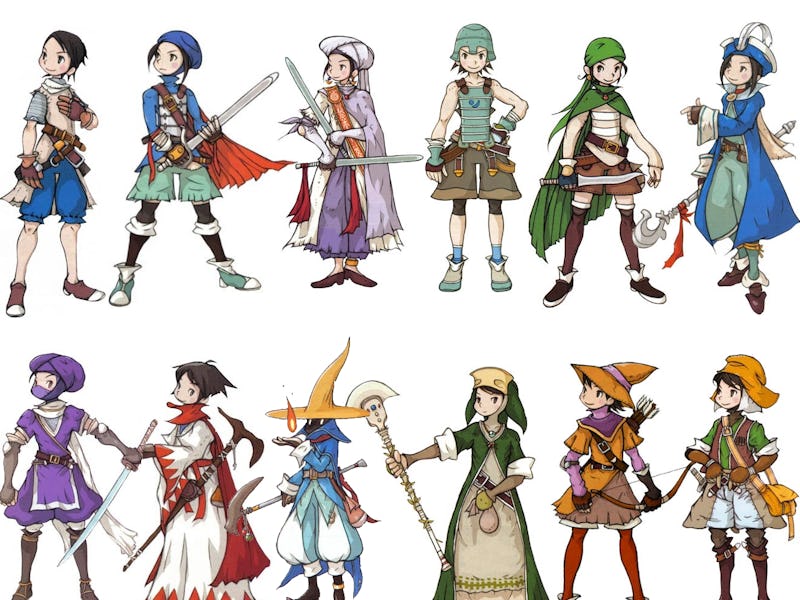20 Years Later, Final Fantasy Tactics Advance Is Still Ahead of Its Time
Not your typical sequel.

Imagine my surprise when I booted up the sequel to my favorite tactical RPG ever on the Game Boy Advance, and rather than assume the role of a noble knight in the land of Ivalice, I was instead put in the dirty shoes of a schoolboy defending a classmate from some bullies in a snowball fight.
Square Enix’s seminal Final Fantasy Tactics from 1997 is a dense tactical RPG full of political intrigue in a magical medieval land ravaged by conflict. A serious and often melodramatic examination of the role religion plays in classism, it remains one of the most influential, and greatest, TRPGs of all time. You’d think developers would take the typical approach to sequels: Refine everything that works while trimming the fat and smoothing out the pain points to make a more efficient and enjoyable experience.
Instead, 2003’s Final Fantasy Tactics Advance — which celebrated its 20th anniversary on February 14, 2023 — complicates the first game’s combat in interesting ways while telling a meta-contextual story that’s far more Chronicles of Narnia than it is Game of Thrones. And, rather than save the world as that noble knight, you’re a stranger in a foreign land whose ultimate goal is to destroy it.
A Dream and a Wish
Marche is a cop.
As Marche Radiuju, you’ve just moved back to your mother’s hometown of St. Ivalice with your infirm younger brother Doned, who’s wheelchair-bound. After defending and bonding with nervous classmate Mewt Randell and the hotheaded Ritz Malheur, they all investigate an old book Mewt found in a store. Surprise: The magical Gran Grimoire manifests each of their dreams all rooted in Mewt's memories of a Final Fantasy game, and they wake up in an Ivalice quite different from Final Fantasy Tactics.
Each child shapes this dream world based on their trauma, and boy do they bring a lot of grim trauma to the table.
Doned has a mysterious illness in the real world but has the use of his legs in Ivalice and even leads an adventuring group. He and Marche’s parents are freshly divorced, which is why they had to leave the town they grew up in to move with their mother. Ritz had been picked on her entire life for her albino hair, but in Ivalice, she’s a powerful warrior with red hair. And poor Mewt: After his mother perished, he clung to the teddy bear she gave him as his father struggled with addiction and depression. But in Ivalice, he is a crown prince, and his father is the Judge that leads the royal army.
Cover art depicts the kids in the real world perusing the book that would change everything.
Marche has a dogged sense of justice, and as the leader of an adventuring clan, he works to undo the dreamworld that they’ve created — particularly because they dragged tons of innocent people into it. Each of his former friends tries to impede his progress to varying extremes. The internal and external struggles at play ultimately teach us that escapism is dangerous and radical acceptance is the only way to ever gain any semblance of happiness.
Tactics Advanced
FFTA features many of the same playable jobs from the first game but adds a few more, some of them exclusive to the newly introduced character races: Moogles, a Final Fantasy staple, are small and quick. The reptilian Bangaa are slower and stronger than average. The cow-looking Nu Mou are good with magic. And the beloved Viera is a graceful, feminine, rabbit-eared race. This naturally complicates how the player approaches team composition.
While it’s a mostly linear narrative, FFTA does offer several different types of activities and combat encounters that elevate it in terms of complexity — at least gameplay-wise — compared to the original. The most noteworthy change here, however, is the Law System wherein an uber-powerful Judge resides over almost every combat encounter. Specific laws restrict what you cannot and what you should do in battle. If a character breaks the law too much, then they can straight-up go to jail!
This adds an occasionally frustrating but always interesting complication to your typical TRPG strategic approach. The end result is a game whose combat and progression is perhaps even more gripping than the original.
Of Its Era
Character illustrator Ryoma Ito drew this artwork of Marche Radiuju and Montblanc to celebrate the 20th anniversary of Final Fantasy Tactics Advance.
In hindsight, Final Fantasy Tactics Advance emphasizes a lot of gameplay and storytelling trends that were popular in the early aughts, particularly within Square Enix. FFTA utilizes an Ability Point (AP) system almost identical to 2000’s Final Fantasy IX wherein characters learn abilities over time from their equipped items, but once mastered, they can use them forever.
Also curious: FFTA was released shortly after the MMORPG Final Fantasy XI but not long before Final Fantasy X-2, both games that put great emphasis on jobs or classes at the core of the gameplay experience. FFTA was also released mere weeks before Kingdom Hearts, another isekai tale where a trio of childhood friends is suddenly thrust into a fantastical multiverse and separated. FFTA also set the stage for Final Fantasy XII by establishing Ivalice as arguably the single most prolific setting in franchise history.
In short, two decades later, FFTA feels like a time capsule that captured a very specific moment in gaming history, and it remains an oft-forgotten influential part of Final Fantasy history.